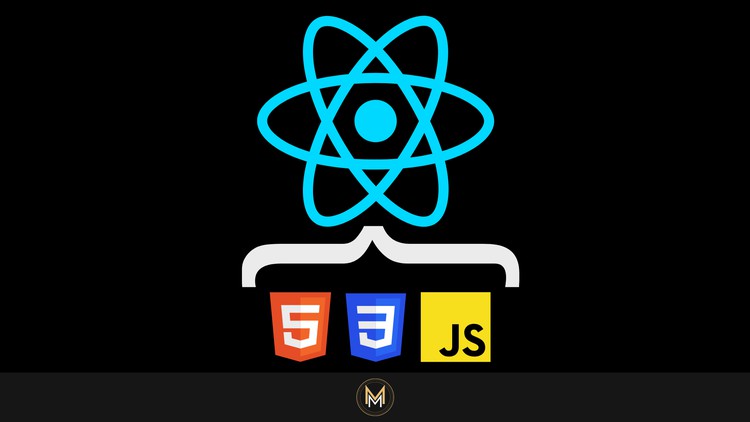React for Beginners – From HTML CSS & JavaScript to React.js
Complete React Guide including (incl Hooks, React Router, Redux, Styled Components)
What you’ll learn
React for Beginners – From HTML CSS & JavaScript to React.js
-
React Fundamentals: Learn the basic concepts of React, including components, JSX (JavaScript XML), state, props, and the component lifecycle
-
Component-based Architecture: React is based on a component-based architecture, and students will learn how to design and create reusable components.
-
React Router: a library that enables navigation and routing in React applications. Set up routes, handle URL parameters, and create nested routes.
-
State Management: React provides various techniques for managing application state.
-
Hooks: React Hooks revolutionized how developers write React components. Students will learn about different hooks, such as estate, use effect, use context, etc
-
Forms and User Input: Learn how to handle form submission, validation, and user input using React.
-
Styling in React: Learn various approaches to styling React components, including CSS modules, inline styles, CSS-in-JS libraries like styled-components
-
Asynchronous Data Fetching: Learn data fetching data from APIs. learn techniques to handle asynchronous operations using features like the fetch API & Axios.
-
Deployment and Build Processes
Requirements
-
Basic HTML CSS and JavaScript
Description
Welcome to my comprehensive React course for beginners! If you’re someone who has experience with HTML, CSS, and JavaScript and wants to take your web development skills to the next level, then this is the course for you.
Throughout this course, I’ll guide you through the basics of React, including how to build and structure React components, use React hooks, and create multiple projects to help you practice your newfound skills.
To start, we’ll take a look at what React is and why it’s such an important tool in the web development industry. React is a JavaScript library used for building user interfaces, and it’s become incredibly popular over the years due to its flexibility and ease of use. Many companies, such as Facebook, Instagram, and Airbnb, use React to build their web applications.
With that in mind, we’ll dive into the basics of React, including how to set up your development environment, create a basic React component, and render that component to the browser. From there, we’ll explore the various React components that you can use, such as function components and class components, and how to structure your components in a way that makes sense for your application.
Next, we’ll delve into React hooks, which are functions that let you use state and other React features without writing a class. We’ll go through the various hooks, including useState, useEffect, useContext, and more, and show you how to use them in your applications to make your code more concise and easier to read.
Finally, we’ll round out the course with multiple projects that you can work on to apply your newfound knowledge. These projects will include creating a simple to-do list application, a movie search application, and a weather app. By the end of the course, you’ll have a solid understanding of how to build React applications and the confidence to create your projects.
In conclusion, our React course for beginners is the perfect way to take your web development skills to the next level. With our comprehensive approach, we’ll guide you through the basics of React, teach you how to use React components and hooks and provide you with multiple projects to practice your skills. React is an important tool in the web development industry, and with this course, you’ll be well on your way to becoming a proficient React developer.
Here is a list of all the hooks available in React and I will be teaching in this course, along with a short description of what they do:
- state: Allows you to add a state to a functional component by providing a state variable and a function to update it.
- use effect: Allows you to perform side effects (such as fetching data or updating the DOM) after a component has rendered or before it’s about to unmount.
- use context: Allows you to access data stored in a context object without having to pass props down through multiple levels of components.
- useReducer: Allows you to manage complex states predictably, by taking in a reducer function and an initial state value.
- use callback: Allows you to memoize a function, which can help with performance by preventing unnecessary re-renders of child components.
- useMemo: Allows you to memoize a value, which can help with performance by preventing unnecessary calculations.
- user: Allows you to create a mutable reference to a value or DOM element, which can be useful for accessing the DOM directly or persisting values across renders.
- useLayoutEffect: Similar to useEffect, but runs synchronously after all DOM mutations have been completed, which can be useful for manipulating the DOM directly.
- useImperativeHandle: Allows you to customize the instance value that’s exposed to parent components when using ref.
- useDebugValue: Allows you to add a label to a custom hook, which can be useful for debugging and tracing the flow of data in your application.
These hooks are some of the most commonly used ones in React and can be incredibly powerful when used correctly. By understanding how each hook works and when to use it, you can build more complex and performant applications with ease.
Dear aspiring developers,
Welcome to the extraordinary world of React.js! My name is Norbert B.M I am a self-taught web developer and Today, we gather here to embark on a transformative journey that will take you from the realms of HTML, CSS, and JavaScript to the captivating universe of React.
In this course, I have crafted a learning experience tailored specifically to guide you through this remarkable transition. My primary focus is to bridge the gap between your existing knowledge and the intricacies of React.js. Together, we will lay a solid foundation upon which you can build your expertise and create captivating web applications.
React.js, with its elegance and power, opens up new possibilities in the realm of web development. It empowers you to craft highly interactive, efficient, and scalable user interfaces. This revolutionary library will change the way you approach building websites, elevating your skills to new heights.
Throughout this course, we will embark on an immersive journey, gradually introducing you to React.js concepts and techniques. We will start by revisiting and reinforcing your understanding of HTML, CSS, and JavaScript, ensuring a strong footing for the adventure ahead.
As we progress, we will delve into the fundamental building blocks of React.js, such as components, states, and props. You will learn how to break down complex user interfaces into modular pieces, enabling reusability and maintainability in your codebase.
Through practical exercises and engaging projects, you will witness firsthand the transformative power of React.js. I will be by your side, offering my expertise, guidance, and support every step of the way. My real-world experiences will illuminate the path, providing valuable insights and best practices.
While this journey may present challenges, I believe in your potential to overcome them. I have carefully designed this course to provide a nurturing and inclusive environment where you can learn, explore, and grow. Together, we will unravel the mysteries of React.js, unlocking the doors to a world of endless possibilities.
So, my fellow learners, are you ready to embark on this transformative journey? Are you prepared to witness your skills evolve and witness the magic of React.js unfold before your eyes? If so, then join me as we set forth on this exhilarating adventure.
Embrace the power of React.js, and let us embark on this extraordinary voyage together!
I am Norbert BM, see you in the course!
Who this course is for:
- Beginner Web Developers: If you are new to web development or have basic knowledge of HTML, CSS, and JavaScript, this course can be a great starting point for learning React. It provides a solid foundation and introduces you to the key concepts and techniques used in building React applications.
- Front-end Developers: If you are already familiar with front-end development and want to expand your skills by learning React, this course can help you enhance your knowledge and enable you to build more interactive and dynamic user interfaces.
- JavaScript Developers: If you have experience with JavaScript but have not yet worked with React, this course can help you dive into the world of React and learn how to leverage its features and benefits in your projects.
- UI/UX Designers: If you are a UI/UX designer who wants to have a better understanding of how to implement your designs in code and create interactive prototypes, learning React can be valuable. This course will teach you the necessary skills to bring your designs to life using React.
- Backend Developers: If you have experience with backend development and want to expand your skill set to include front-end development using React, this course can help you bridge that gap and understand how to integrate React components into your existing projects.
- Anyone Interested in React: If you have a general interest in React and want to explore its capabilities and possibilities, this course can serve as a comprehensive introduction. It is designed to cater to individuals with varying levels of programming experience.










